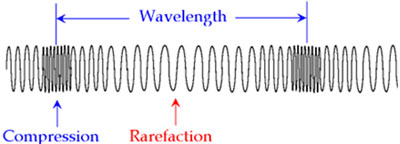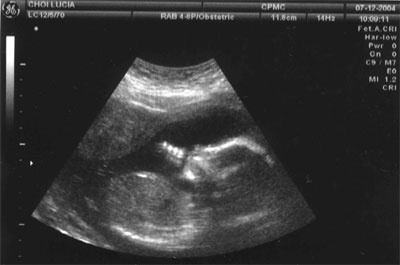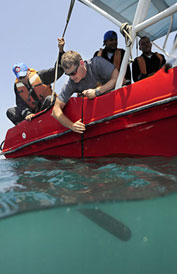
Adapted from: Longitudinal-Wave, Science-Class.net

Adapted from: Longitudinal-Wave, Science-Class.net
As you learned earlier in this module, a sound wave is an example of longitudinal wave. Sound waves not only transmit sound but are also used by those working in medicine and industry. In this section, you will explore how sound waves are used in medicine and industry.

Source: Baby in ultrasound, Sam Pullara, Wikimedia Commons
For some patients, the use of X-rays is too dangerous, and other imaging techniques are needed. In the case of pre-natal care for pregnant women, ultrasound imaging is used to keep track of the developing fetus. An ultrasound machine emits a very high-frequency sound wave that is reflected back from different tissues within the body. The density of the tissue affects the way the wave bounces back, and the ultrasound machine is specially programmed to read these differences to create an image.
Ultrasonography creates a blurrier image than X-rays, but it is not as potentially harmful. Another advantage of ultrasound is that it can show differences in soft tissue. X-rays are used for harder tissues.
Ultrasonography is important to medicine because it can be used diagnostically and therapeutically. Focused sound waves can be used to clean your teeth, to break up a cloudy film called a cataract that can cover the lens of your eye, and even to break up gallstones and kidney stones.
In addition to use of ultrasound, scientists are learning more about how to use sound in the medical field. Current research is being done on the use of sound to control bleeding and for the development of miniscalpels.
Team uses SONAR to Perform underwater maintenance

Source: Official U.S. Navy Imagery - Navy divers perform underwater maintenance to USS Emory S. Land, By Official Navy Page from United States of America MC2 KAHTLEEN GORBY/U.S. Navy, Wikimedia commons
Sound waves are also used in research and industry. The following examples are a few of the ways sound is used.
Sonar is very effective at following the motion of underground objects and reading the composition of underwater currents. Sonar works by sending out a sound wave into the water. The echo that you hear when it bounces off solid objects or different densities of water can then be analyzed. Marine biologists can use sonar to track the motions of sea turtles to learn more about their migration habits or to see if there are changes in the primary ocean currents around the world.
Ultrasonic waves are used for cleaning delicate instruments by vibrating the cleaning liquid at a high frequency. Ultrasonic waves are also used for detecting flaws and cracks in metal. Much like an ultrasound, this process works by sending a signal and then waiting for the waves to bounce back. Each material has a different return time. Using these return times, scientists are able to detect where the cracks and flaws are located.
In the next section, you will look at how transverse waves are used in medicine.